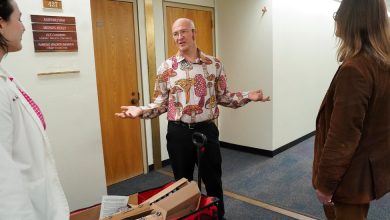Prince Andrew, Banished From Royal Duties, Escorts Queen to Memorial

LONDON — Six weeks ago, Prince Andrew agreed to a multi-million-dollar legal settlement with a woman who accused him of raping her when she was a teenager. On Tuesday, he escorted his mother, Queen Elizabeth II, to a memorial service at Westminster Abbey to celebrate the life of her late husband, Prince Philip.
The prince’s very conspicuous public appearance on the queen’s arm, his first since Philip’s funeral last April, sent an unmistakable message of support by a 95-year-old mother for her disgraced son. But it struck some royal watchers as incongruous, given that she stripped Andrew of his military titles and all but banished him from public life after he was engulfed in the sexual abuse lawsuit.
Andrew’s sudden re-emergence came days after a trouble-prone tour of the Caribbean by Prince William and his wife, Catherine, the Duchess of Cambridge, during which the couple confronted a backlash over issues of racial justice and rising sentiment to cast off the queen as head of state in Jamaica and other former colonies.
“It didn’t happen by happenstance,” Peter Hunt, a former royal correspondent for the BBC, said of Andrew’s role. “There must have been thinking behind it. You have to come to the conclusion that it was an opportunity for her to actively endorse her son, to point out that he hasn’t been found guilty of anything.”
While Andrew did not acknowledge guilt in the settlement with the woman, Virginia Giuffre, he agreed to pay her, as well as a charity “in support of victims’ rights,” a sum that British tabloids reported to be well in excess of $10 million. He commended Ms. Giuffre for her bravery in coming forward to talk about her treatment by the financier and sexual predator, Jeffrey Epstein, with whom the prince was friendly.
Royal watchers often say the queen is especially fond of Andrew, whose past as a helicopter pilot echoes the military service of her husband.
But after Andrew, 62, failed to persuade a federal judge in Manhattan to dismiss the lawsuit, Buckingham Palace moved to distance itself from him. It announced he would relinquish his military titles and royal charities, as well as the title, “His Royal Highness.” He would defend himself as a private citizen, the palace added, and would “continue not to undertake any public duties.”
At the time, palace officials described this punishment as permanent, saying it had come after extensive deliberations within the family. There would be no avenue for Andrew, who is known as the Duke of York, to rehabilitate himself. It is not known whether Prince Charles, the heir to the throne, or his eldest son, Prince William, the second in line, were involved in planning the ceremony on Tuesday.
“Did Charles and William attempt to intervene and did they fail? Or did they not bother to raise it?” Mr. Hunt said. “I would be amazed if nobody raised it,” he added, referring to the broader palace staff.
Ultimately, of course, the decision was up to the queen, for whom this was a deeply solemn, emotional ceremony. Philip, who died last April at 99, was buried in an austere funeral at Windsor Castle, under strict Covid restrictions, which limited attendance to 30 people and forced the queen to grieve for her husband of 73 years, masked and alone in a choir stall at St. George’s Chapel.
Some Key Moments in Queen Elizabeth’s Reign
Becoming queen. Following the death of King George VI, Princess Elizabeth Alexandra Mary ascended to the throne on Feb. 6, 1952, at age 25. The coronation of the newly minted Queen Elizabeth II took place on June 2 the following year.
A historic visit. On May 18, 1965, Elizabeth arrived in Bonn on the first state visit by a British monarch to Germany in more than 50 years. The trip formally sealed the reconciliation between the two nations following the world wars.
First grandchild. In 1977, the queen stepped into the role of grandmother for the first time, after Princess Anne gave birth to a son, Peter. Elizabeth’s four children have given her a total of eight grandchildren, who have been followed by several great-grandchildren.
Princess Diana’s death. In a rare televised broadcast ahead of Diana’s funeral in 1997, Queen Elizabeth remembered the Princess of Wales, who died in a car crash in Paris at age 36, as “an exceptional and gifted human being.”
Golden jubilee. In 2002, celebrations to mark Elizabeth II’s 50 years as queen culminated in a star-studded concert at Buckingham Palace in the presence of 12,000 cheering guests, with an estimated one million more watching on giant screens set up around London.
A trip to Ireland. In May 2011, the queen visited the Irish Republic, whose troubled relationship with the British monarchy spanned centuries. The trip, infused with powerful symbols of reconciliation, is considered one of the most politically freighted trips of Elizabeth’s reign.
Breaking a record. As of 5:30 p.m. British time on Sept. 9, 2015, Elizabeth II became Britain’s longest-reigning monarch, surpassing Queen Victoria, her great-great-grandmother. Elizabeth was 89 at the time, and had ruled for 23,226 days, 16 hours and about 30 minutes.
Marking 70 years of marriage. On Nov. 20, 2017, the queen and Prince Philip celebrated their 70th anniversary, becoming the longest-married couple in royal history. The two wed in 1947, as the country and the world was still reeling from the atrocities of World War II.
Losing her spouse. In 2021, Queen Elizabeth II bade farewell to Prince Philip, who died on April 9. An image of the queen grieving alone at the funeral amid coronavirus restrictions struck a chord with viewers at home following the event.
Tuesday’s service featured a much larger guest list, including the filmmaker David Attenborough, who bonded with Philip over environmental issues. Prince Harry and his wife, Meghan, who now live in California, did not attend.
Whether the queen would make the trip from her residence at Windsor was unclear until the last minute. It was the first public occasion she has attended outside one of her residences since last October, when she abruptly canceled several appearances, suffering from what officials said was exhaustion. In February, Elizabeth tested positive for the coronavirus.
The queen appeared frail but resolute at Westminster Abbey, a walking stick in her right hand as Andrew guided her from the Poets’ Yard entrance to the front row. The service was kept to a brisk, 45 minutes. Elizabeth looked teary-eyed at one point, but she stood up and down and sang several hymns.



